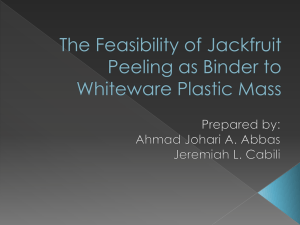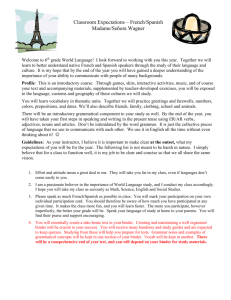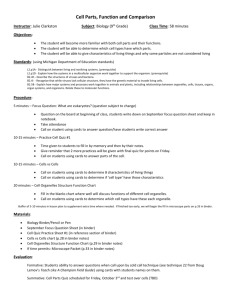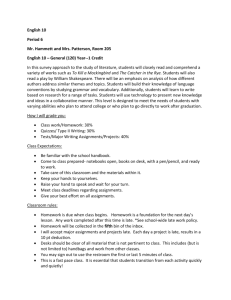THE FEASIBILITY OF JACKFRUIT PEELING(Revise - ids
advertisement
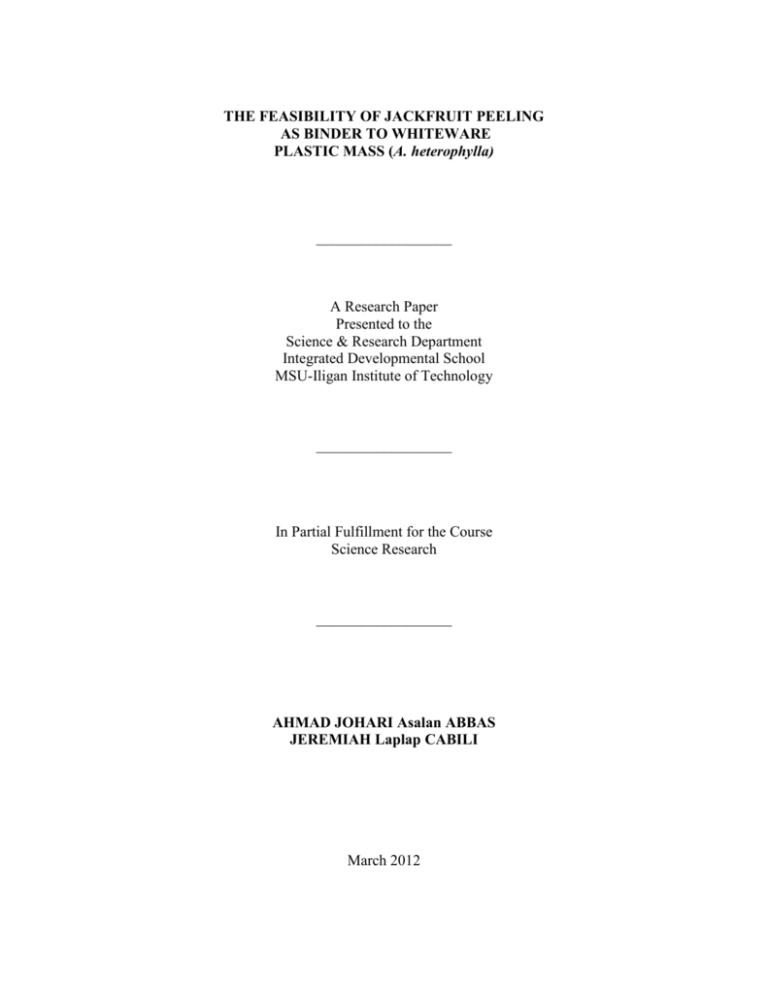
THE FEASIBILITY OF JACKFRUIT PEELING AS BINDER TO WHITEWARE PLASTIC MASS (A. heterophylla) __________________ A Research Paper Presented to the Science & Research Department Integrated Developmental School MSU-Iligan Institute of Technology __________________ In Partial Fulfillment for the Course Science Research __________________ AHMAD JOHARI Asalan ABBAS JEREMIAH Laplap CABILI March 2012 APPROVAL SHEET This research paper entitled “THE FEASIBILITY OF JACKFRUIT PEELING AS BINDER TO WHITEWARE PLASTIC MASS (A. heterophylla))” prepared and submitted by AHMAD JOHARI Asalan ABBAS and JEREMIAH Laplap CABILI Adviser ________________ Date Panel Member Panel Member Date Date Technical Consultant (optional) ___________________ Date Accepted and approved in partial fulfillment of the Course in Science Research I/II. Chairperson, Science & Research ____________ Date Principal, IDS ____________ Date CHAPTER I INTRODUCTION A. Background of Study In order to successfully form plastic masses, the use of additives and processing aids have always been a must. Binders have been called the most important processing additive of the Ceramic Sintering Process (also firing) and along with other additives (Cerchio, 2006). The role of the binder includes aggregation and holding the different whiteware components during the firing process to acquire clean and uniform heating while providing exceptional green strength to the sintered parts. Ceramic Binders are quite expensive and the utilization of Ceramic binders from local and cheaper materials is also quite a necessity considering the low economic status of different countries especially, Philippines. Carboxymethyl Cellulose (a kind of binder) costs $2000$3000/metric ton (Market Price, Hefei Changming Co., Ltd. 2011) and are even imported from outside the country thus, the price increases and is multiplied when it reaches the local market. The Researchers of the study plan to use the Jackfruit peeling as the raw material of the target alternative binder. Almost all the parts of the Jackfruit tree including its fruit secretes latex when injured which is a good factor when it comes to binding. The Jackfruit peeling itself also contains cellulose which is the chief component of plants’ cell walls. Cellulose products such as the Carboxymethyl Cellulose are used as binder. 1 The study will evaluate the effectiveness of Jackfruit peeling as the raw material for an alternative binder. Furthermore, the study will determine the plasticity, liquid and plastic limit of the standard whiteware mass that will be used for the plastic mass formulation. B. Statement of the problem The study will evaluate the feasibility of the Jackfruit peeling as an effective raw material in the formulation of alternative ceramic binder to standard whiteware plastic mass. Sub-problems 1) What are the characteristics of the new plastic masses using water as ceramic binder and the characteristics of the new plastic masses using jackfruit pulp as ceramic binder in terms of their: a. shrinkage b. modulus of rupture c. loss on ignition 2) Is there a significant difference between the plastic masses using water and jackfruit pulp as binder? 2 C. Hypotheses a. There is no significant difference between the new plastic masses using water and jackfruit pulp as binder. b. The alternative binder utilized from Jackfruit peeling is not an effective raw material of the said formulation. c. The plastic mass formed with the use of the alternative binder utilized from Jackfruit peelings is not comparable to plastic masses formed with use of artificial binders. D. Objectives of the study The study aims: 1. To determine the effectiveness of the Jackfruit Peeling as raw material to alternative binder. 2. To determine the shrinkage of the new plastic masses formed with binder utilized from Jackfruit peeling. 3. To determine the modulus of rupture of the new plastic masses formed with binder utilized from Jackfruit peeling. 4. To determine the loss on ignition of the new plastic masses formed with binder utilized from Jackfruit peeling. 3 E. Significance of the study Considering the low economic status of many countries especially Philippines, the need of producing alternative products in place of commercial products have been the main pursuit of many researchers nowadays. The importance of ceramic binders, as a part of a growing industrial country became more apparent because of the growing needs of ceramic engineering that requires ceramic binders, and the goal of the researchers in this study to produce a better alternative material using the Jackfruit peeling as the raw material came in as one of the good solutions on contributing in the economic growth of the country. Since we import binders from outside the country, having an alternative and cheaper binder is major step in our economy. Besides the future contribution of this study to our economy, this study also aims to lessen the waste level production in our society. Successfully coming up of a way of utilizing waste products such as usually disposed jackfruit peeling into useful products like alternative binders is also a major step in solving one of the major problems of the country – too much waste disposal. Since Jackfruit peeling is one of the fruit which is abundant in our country, using it as a raw material to alternative binders is one way of promoting our own products. This study will open many opportunities especially in the field of ceramic engineering in our country and give way to the production of binders in our country. The ceramic engineers in our country will no longer need to import ceramic binders which will decrease the production price of plastic masses and thus also decreases the price of plastic masses (porcelains, plastic wares and the like) in the local market. 4 The success of this study will also give way to the exportation of binders outside the country which will improve the net profit of the businessmen in the country thus also improving the salaries of both employees and employers of businesses in the field of ceramics thus again, will contribute to the economy our country. F. Scope and Limitation This study will utilize the Jackfruit peeling as the raw material to the alternative binder; it will be mixed with water to form an alternative binder. The study will also focus on the determination of shrinkage, modulus of rupture and loss on ignition of the new plastic masses using water and jackfruit pulp as ceramic binder. G. Definition of Terms Jackfruit a species of tree in the Artocarpus genus of the mulberry family (Moraceae). Jackfruit peeling is used in our study as the source of cellulose and latex that will be the main materials needed in producing binders. Cellulose a complex carbohydrate, or polysaccharide, consisting of 3,000 or more glucose units. The basic structural component of plant cell walls, cellulose comprises about 33 percent 5 of allvegetable matter (90 percent of cotton and 50 percent of wood are cellulose) and is the most abundant of all naturally occurring organic compounds. In ceramic engineering, cellulose products such as Carboxymethyl Cellulose are used as binders. Besides its latex content, jackfruits also contain cellulose. Binder is a ceramic ingredient which binds or holds the ceramic particles such as clay particles and powder particles. It also gives dry and wet strength to the body of ceramic particles. It will be the goal of the study to produce an effective alternative binder using the jackfruit peeling as a raw material. Ceramics a term applied to all useful or ornamental clay objects that are baked. It includes both pottery and porcelain. Any clay object fashioned from earth and hardened by baking, either in the or by firing is considered pottery. This study encompasses the formation of ceramics since it includes firing process. Shrinkage is the rate at which the body shrinks during drying and firing. This characteristic is interrelated and affected by the clay body formulation and by the firing time and temperature. This study will use the determined shrinkage of the new plastic masses using jackfruit peeling and water as binders to evaluate the effectiveness of jackfruit peeling as raw material to alternative binders. 6 Modulus of Rupture is the ultimate strength determined in a flexure or torsion test. In a flexure test, modulus of rupture in bending is the maximum fiber stress at failure. This study will use the determined modulus of rupture of the new plastic masses using jackfruit peeling and water as binders to evaluate the effectiveness of jackfruit peeling as raw material to alternative binders. Loss on Ignition is a test used in inorganic analytical chemistry, particularly in the analysis of minerals. It is designed to measure the amount of moisture or impurities lost when the sample is ignited under the conditions specified in the individual monograph. . This study will use the determined loss on ignition of the new plastic masses using jackfruit peeling and water as binders to evaluate the effectiveness of jackfruit peeling as raw material to alternative binders. Standard Whiteware Plastic Mass a pre-mixed clay made of 25% ball clay, white clay, feldspar and quartz (Valencia L.T., 2006). Standard Whiteware Plastic Mass will be formed in the study using jackfruit peeling as its binder. Its Plasticity, Plastic Limit and Liquid Limit will be determined and will be used as reference in evaluating the feasibility of jackfruit peeling as binder to Standard Whiteware Plastic Mass. 7 CHAPTER II REVIEW OF RELATED LITERATURE AND RELATED STUDIES The jackfruit (Artocarpus heterophyllus or A. heterophylla) is a species of tree in the Artocarpus genus of the mulberry family (Moraceae). It is native to parts of Southern and Southeast Asia. It is the national fruit of Bangladesh, (locally called Kathal). The jackfruit tree is believed to be indigenous to the southwestern rain forests of India. It is widely cultivated in the tropical regions of Indian subcontinent, Vietnam, Thailand, Malaysia, Indonesia. Jackfruit is also found in East Africa e.g. in Uganda and Mauritius, as well as throughout Brazil and Caribbean nations like Jamaica. It is well suited to tropical lowlands, and its fruit is the largest tree-born fruit, reaching 80 pounds (36 kg) in weight and up to 36 inches (90 cm) long and 20 inches (50 cm) in diameter. The jackfruit tree casts a very dense shade. Heavy side branching usually begins near the ground. Outside of its countries of origin, fresh jackfruit can be found at Asian food markets, especially in the Philippines. It is also extensively cultivated in the Brazilian coastal region, where it is sold in local markets. It is available canned in sugar syrup, or frozen. Dried jackfruit chips are produced by various manufacturers. In northern Australia, particularly in Darwin, Australia, jackfruit can be found at outdoor produce markets during the dry season. Outside of countries where it is grown, jackfruit can be obtained year-round either canned or dried. It has a ripening season in Asia of late spring to late summer. 8 All parts of the tree exude sticky white latex when injured. The latex contains resins that may have use in varnishes. The latex also has bacteriolytic value comparable to that of papaya latex. Additionally, the sticky latex is used for trapping birds (birdlime) and for insect traps. The heated latex can be used as glue for mending chinaware (a kind of whiteware known for its high strength and impact resistance and also for low water absorption – all deriving from the high glass content) and pottery and as caulking for boats and buckets. (Elevitch & Manner, 2006) Whiteware is any of a board class of ceramic products that are white to off-white in appearance and frequently contain significant vitreous or glassy component. Whitewares are often referred to as triaxial bodies, owing to the three mineral types – clay, silica/flint and feldspar – consistently found in their makeup. Clay is the plastic component, giving shape abilities to the unfired product and also serving as a glass former during firing. Flint is the common name used in the industry for all forms of silica serves as a filler, lending strength to the shaped body before and during firing. Feldspar serves as a fluxing agent, lowering the melting temperatures of the mixture. These raw materials are mixed with ceramic binders to hold them together and keep them intact during processing and firing. This is necessary until the whiteware processing is complete. A ceramic binder is a processing additive. In ceramic processing, binders are the polymer molecules and coagulate colloidal particles that are adsorbed and bridges between ceramic particles to provide inter particle binding action. 9 An adsorbed binder may improve the wetting of the particle. A binder usually increases the apparent viscocity of the processing. The settling of particles in suspension may be reduced on adding binders. The flow properties of slurry can be controlled but binder type and concentration. The most important function of the binder is to improve the as-formed strength of the product for handling before firing. (Huang 2006) Table 1 Type of Binders Colloidal Particle Type Organic Inorganic Microcrystalline Cellulose Kaolin, Ball Clay Molecular Type Organic Examples Inorganic Examples Polysaccharides Refined Starch Soluble Silicates Sodium Silicate Polymerized Alcohol Polyvinyl Alcohol Organic Silicates Ethyl Silicate Polymerized Butyral Polyvinyl Butyral Soluble Phosphates Alkali Phosphate Acrylic Resins Polymethyl Soluble Aluminates Sodium Aluminate Methacrylate Glycols Polyethylene Glycol Adding ceramic binder during processing and firing is also necessary to improve the shrinkage of the material. 10 Shrinkage is the rate at which the body shrinks during drying and firing.(Zamek 2003) Drying shrinkage refers to reduction in dimension of new concrete, dimensional lumber, cement plaster, plywood, asphalt paving and other materials which have dried or experienced significant reduction in moisture content. (Geary 2011) Firing Shrinkage on the other hand refers to the reduction in dimension during firing. Modulus of Rupture is the measure of the force necessary to break a given substance across, as a beam, expressed by eighteen times the load which is required to break a bar of one inch square, supported flatwise at two points one foot apart, and loaded in the middle between the points of support. (Rankine 2011) The feasibility of certain binders can also be tested using the Loss on Ignition (LOI) test as it was used in a previous study titled “The Feasibility of Marang Peeling as Binder to the Standard Whiteware Plastic Masses” by David Dwight Alip. (Alip 2007) Loss on Ignition test is designed to measure the amount of moisture or impurities lost when the sample is ignited under certain conditions. (Zaidan 2011) 11 Another related study was conducted to determine the plasticity, liquid limit, and the plastic limit of the plastic masses using water and marang pulp as binder. It was titled “Evaluation of the Marang Peeling as Binder to the Standard Whiteware Plastic Masses”, and it used marang pulp (considering its latex content) as the main raw material of the binder used to form standard whiteware plastic masses instead of commercial/expensive materials. A comparison was made between marang pulp and water as binder to standard whiteware plastic masses. Based on the results of the study, the researcher concluded that there was no significant difference between the plastic limits of the plastic masses with respect to the plastic masses (new and aged) and the type of binder being used. The plasticity of the plastic masses also has no significant difference with respect to the plastic masses being used. However, the type of binder used has a highly significant effect in the plasticity of the plastic masses. Regarding the liquid limit, results of the study have shown significant difference between the liquid limits using different binders. (Cabili, 2007) (To find another alternative binder that can be used as a binder to standard whiteware plastic masses, the researchers of the present study will use Jackfruit Peeling instead of Marang Pulp as binder to standard whiteware plastic masses.) 12 Another study titled “Leatherette from Jackfruit Peelings” was conducted with the purpose of making leatherette utilizing only ripe jackfruit peelings and gelatin. The leatherette produced showed characteristics similar to that of genuine leather. The said study also sought to determine the effects of the relative amounts of gelatin to jackfruit peelings on the effectiveness of the leatherette. The leatherette made was subjected to different tests namely, tests for pliability, porosity, quality and force applied. Based on the results obtained from the study, it was concluded that the more gelatin added, the stronger the leatherette. Usage of binders other than gelatin was also recommended. It was also recommended that the latex present in the jackfruit can be utilized as a binder. (Padate, 2001) (The information gathered regarding the effectiveness of Jackfruit Peeling as the raw material of leatherette on the said paper will be used as a reference by the researchers of the present study.) The related literature and the related studies gathered supports the idea of jackfruit peeling as an effective binder to standard whiteware plastic masses since it was said that it has latex content. Also considering the sticky nature of latex, using it in effectively binding materials is a significant study. The raw materials in making standard whiteware plastic masses (clay, flint and feldspar) will be used in the study. The information about the ceramic binder will serve as a reference in determining the effectiveness of the jackfruit peeling as binder. 13 The knowledge obtained about the Shrinkage Limit and Modulus of Rupture will be useful in determining each of them accurately. The Loss on Ignition test will also be useful in determining the feasibility of Jackfruit pulp as an alternative ceramic binder. Previous studies have used similar materials like marang pulp in producing binder. Some studies have already used jackfruit peeling as a binder to different materials such as leatherette which is mentioned previously. However, the utilization of jackfruit peeling as a ceramic binder (which is the goal of this present study) is a new study in providing an alternative binder that is also comparable and similar to the commercial binders or even more effective and efficient. 14 CHAPTER III METHODOLOGY A. Research Design Complete Randomized Design will be used in this study. The experimental subjects are homogenous since we are only going to use one kind of standard whiteware plastic mass powder. Each of the experimental subjects will be randomly distributed to each of the two treatments of the study. The preparation of the binder (jackfruit pulp) will be made at the researchers’ house and the experimentation of that binder will be conducted at the College of Engineering (COE) laboratory, MSU-Iligan Institute of Technology, Iligan City. B. Materials and Equipments Materials: Jackfruit peeling (raw material to alternative binder) Standard Whiteware Plastic Mass Powder Spatula Glass Panel Tap Water Strainer Graduated Cylinder 15 Measuring Cups Containers Beakers Rectangular Molder Equiments: C. Blender Analytical Balance Weighing Scale Experimental Set-up Table 2 Experimental Set-up Components Treatment A Treatment B (Jackfruit Pulp as Binder) (Jackfruit Pulp as Binder) Jackfruit Pulp (g) 700g 700g Water (mL) 900mL 900mL Plastic mass (g) 1500g 1500g 16 D. Experimental Procedure Preparation of the Jackfruit Pulp as a Binder Jackfruit peelings which are fresh and new including the spines and ragging will be utilized. The peelings will be ground using the blender and sooner or later, an amount of water will be added gradually to form a paste from the jackfruit peeling. To obtain the size of the small particles, it will be strained and preserved in a plastic bottle. Then it will be stored in the refrigerator, ready to be used as a binder to the plastic mass. Preparation of Plastic Mass A volcano will be formed from the Standard Whiteware Plastic Mass powder. For the treatment using jackfruit pulp as binder, jackfruit pulp will be gradually added to the volcano until the mixture hardens (clay-like state). Same will be done using water only as binder. Treatment A & C will be made earlier than treatment B & D since we are aiming to came up with an aged plastic mass. Drying Shrinkage Dry Shrinkage is the shrinkage due to drying only. It is simply the percent change in length between wet and dry. As clay dries, the removal of inter-particle water causes the mass to tighten up and pack together resulting in shrinkage. Variation in dry shrinkage is an indicator of changes in plasticity. 17 Dry Shrinkage differs from Firing Shrinkage in that the former is based on the initial length of the test bar and the latter is based on the dry length (Hansen, 2003). Twenty trials will be made for each of the treatment. The plastic mass will be formed into a rectangular bar using a rectangular molder. The initial length of the rectangular bar will be measured (L0), then, the rectangular plastic mass will be subjected to drying by natural means (sunlight exposure). The length will be measured again (Lf). Percent of shrinkage will be measured to determine the drying shrinkage. To calculate the percent of shrinkage, the length after drying will be subtracted from the initial length divided by the initial length and multiplied by 100 (as shown in the formula below). Drying shrinkage % = 𝐿0 −𝐿𝑓 𝐿0 x 100 Where Li is the initial length of the test bar and Lo is the length of the oven- dry specimen Firing Shrinkage Firing Shrinkage is the amount of shrinkage during firing. As a clay fires, it shrinks and particles continue to pack together. At some point, they begin to break down and react with each other, fluxes begin to melt and flow, and mineral grains seed the development of more stable forms. 18 The firing shrinkage is an indication of the degree to which the complex maturing process has proceeded (Hansen 2003). Twenty trials will be made for each of the treatment. The initial length of the rectangular bar obtained after the determination of the drying shrinkage will be measured (F0), then, the rectangular bar will be sintered (fired). The length of the fired rectangular bar will be measured again (Ff). Percent of shrinkage will be calculated to determine the firing shrinkage of the rectangular bar. To calculate the percent of shrinkage, the length after firing will be subtracted from the initial length divided by the initial length and multiplied by 100 (as shown in the formula below). Firing shrinkage % = 𝐹0 −𝐹𝑓 𝐹0 x 100 Where Fo is the length of the oven- dry specimen and Ff is the length of the fired specimen Modulus of Rupture Determination The rectangular bar will be placed above two supporting blocks. The length and height of the rectangular bar will be measured (L and H, respectively). Distance between the supporting blocks will also be measured (D), then, force will be applied at the center of the rectangular bar using different weights/loads. The total force applied the time the rectangular bar breaks apart will be measured (F). 19 F= Applied Force L = Length of the rectangular bar H = height of the rectangular bar D = distance between the supporting blocks The Modulus of Rupture (M) will then be calculated by the formula, M= 3𝐹𝐷 2𝐿𝐻 2 Loss on Ignition Test To determine the LOI of the rectangular bar, its initial weight will be measured first (W0). It will then be ignited in a kiln or by natural fire until it ceases to change form. The weight will be measured again (Wf) and the loss on ignition will be determined by the percent of weight lost on ignition. The loss on ignition will be calculated numerically by the formula, % LOI = 𝑊0−𝑊𝑓 𝑊0 x 100 20 Preparation of Test bars Needed materials were gathered before molding of test bars was started. A small amount of oil was poured into a clean molder. This was warranted to facilitate the making of the test bar as it will just slide and will not deform (Alip 2007). E. Data Gathering (Tables) Table 3 Jackfruit Pulp as Binder Parameters Treatment A T1 Drying Shrinkage Firing Shrinkage Modulus of Rupture Loss on Ignition T2 T3 T4 T5 T6 T7 T8 T9 T10 AVE 21 Table 4 Jackfruit Pulp as Binder Parameters Treatment A T11 T12 T13 T14 T15 T16 T17 T18 T19 T20 Drying Shrinkage Firing Shrinkage Modulus of Rupture Loss on Ignition AVE 22 Table 5 Water as Binder Parameters Treatment B T1 Drying Shrinkage Firing Shrinkage Modulus of Rupture Loss on Ignition T2 T3 T4 T5 T6 T7 T8 T9 T10 AVE 23 Table 6 Water as Binder Parameters Treatment B T1 T1 T1 T1 T1 T1 T1 1 2 3 4 5 6 7 T18 T1 T2 9 0 AVE Drying Shrinkage Firing Shrinkage Modulus of Rupture Loss on Ignition F. Statistical Tools for Data Analysis A statistical tool called ANOVA (used in Variance Analysis) will be used in the study. The said tool is used in comparing more than two samples instead of using multiple t-tests. 24 G. Procedure Flow Charts 350 g of Jackfruit pulp and 450 ml water. 350 g of Jackfruit pulp and 450 ml water. 350 g of Jackfruit pulp and 450 ml water. 350 g of Jackfruit pulp and 450 ml water. Ground (Blender) 4800 ml of Binder (Approximate Result) Strained (Strainer) 2500 ml jackfruit pulp (ready for use) Figure 1.1 Preparation of Jackfruit Pulp as Binder Formation the Plastic 25 Masses using two different treatments. (Water and jackfruit pulp as binders) Firing and Drying Shrinkage Determination of plastic masses acquired from two different treatments. LOI test to determine the Loss on Ignition of the Plastic masses acquired from two different treatments. Modulus of Rupture Determination of the plastic masses acquired from two different treatments. Analysis of Data Variance using ANOVA. (Comparison of Data) Figure 1.2 Experimental Methodology



